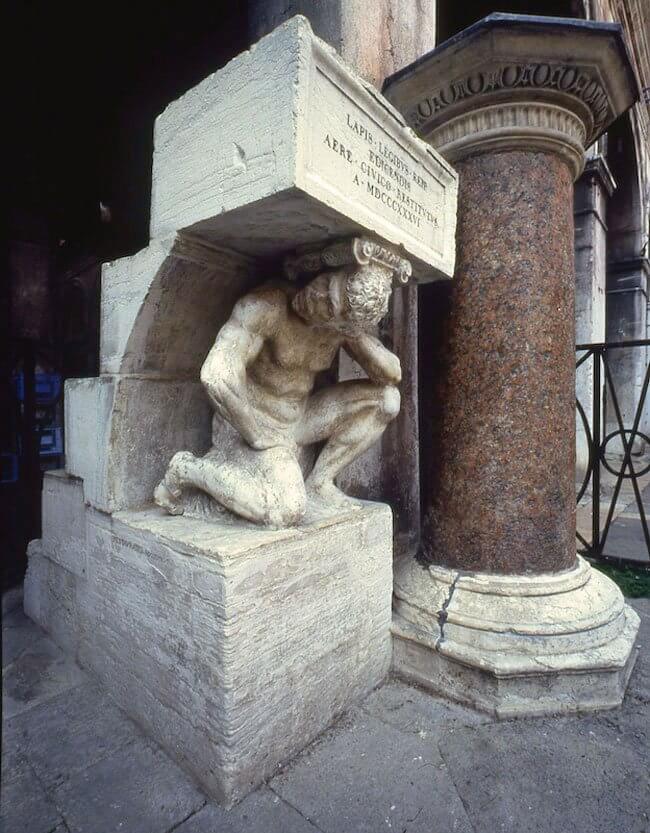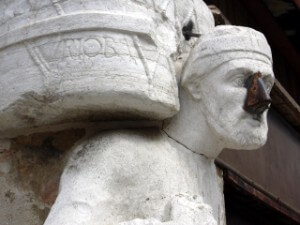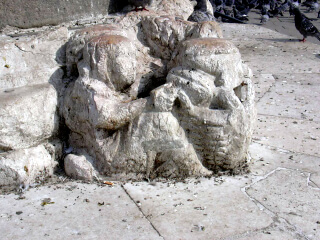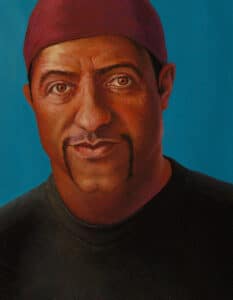- How Hopeful Environmentalists Can Support Environment Protection and Fight Injustice - April 22, 2024
- AI and Activism: Artificial Intelligence in Social Change - April 1, 2024
- How To Be a Feminist Activist: Dismantling Barriers for Women - March 4, 2024
Pasquino, the amazing Talking Statue of Rome, is a witty character who I feature in a blog post about free speech and art.
Because of the stranglehold of the church on Italian society in the 16th century, the Talking Statues of Rome were a way for people to show displeasure with the church and the Popes. You could get in big trouble for speaking out against religious or civil leaders, so Pasquino used Latin poetry to get your message out. Sort of like a fake Twitter account.
The Talking Statues of Venice
I didn’t realize when I wrote the blog post that Pasquino also spoke with a Talking Statue in Venice. My recent trip to Italy included a lovely day in Venice, but I was unaware that nearby stood Gobbo, a Talking Statue of Venice and his friends: Mr. Tony Riobo and Morocco of the Melons.
The Venetians call their statues “Oracles” but they served the same purpose as The Talking Statues of Rome. Venetians were not allowed to speak out against rulers, and in addition, were not allowed to use satire against them. So, of course, the cheeky Italians decided to employ statues to speak for them in a satirical manner. They even used their postal system to send mail to the statues.
Free Speech from Gobbo

Il Gobbo di Rialto (The Hunchback of Rialto), or Gobbo, sits in the commercial district near the Church of San Giacomo. Sculpted in 1541 by Pietro da Salò, Gobbo is ‘hunched’ under a marble set of stairs that lead to a platform on a column used for important announcements.
Official announcements were yelled simultaneously from Gobbo’s column, called the Column of Proclamations, and the one at Piazza San Marco.
Unfortunately, Gobbo had a role in punishing minor financial offenders, and this ended up punishing Gobbo, too. If you committed a minor financial crime you had to strip naked and run through a gauntlet from the Piazza San Marco to Gobbo, while citizens lashed and hit you. At the end of the gauntlet, you had to kiss Gobbo. Poor Gobbo was inadvertently hit, too, and ended up in terrible shape. He was restored in 1836 and protected with a fence.
Apparently, Pasquino decided to involved in Venetian politics by sending messages to Gobbo. They discussed Venetian politics and church officials. Pasquino was what we call today an ‘influencer’.
In some of the articles I researched, the authors speculated that Gobbo the Talking Statue inspired the characters of Launcelot Gobbo and his father in Shakespeare’s The Merchant of Venice.
[Like what you’ve read? Follow the blog so you don’t miss any content.]
Free Speech From Mr. Tony Rioba

Another Venetian oracle is Sior Antonio Rioba, or Mr. Tony Rioba. According to legend, Tony was not a great guy. He and his brothers were traders who defrauded people, and one victim cursed Tony and his brothers and caused them to turn to stone. The statues were displayed in the Campo dei Mori to remind people what could happen to those who were not honest. Tony does not appear to rue his dastardly deeds, though, as shown in one of his messages.
I know that someone has spoken badly about me, but I do not have anything to hide. Yes! is true!, with Maroc and the hunchback, we tattled on everything that passed through Venice, without hard feelings. And honestly, talking gossips are not only for the women.
Tony inspired a newspaper called The Shadow of Sior Antoni Rioba. He was probably embarrassed when he lost his nose in the 1800’s and it was replaced with an iron one. I’m not sure why this is the case, but rubbing his iron nose is supposed to bring you good luck.
In 2010, someone took Tony’s head. This caused an uproar in Venice but happily, they located his head in a nearby canal and restored it to his body.
Free Speech From Morocco of the Melons

Morocco was most likely a grocer who sold melons since he shown holding a basket of them in the Piazza San Marco.
I looked at several pictures of Morocco and it’s hard to tell he’s holding a basket of melons, or even that he is a man. He is looking rough.
He likely became a Talking Statue because of his great location, near many powerful people.
Free Speech and Art
In order to speak out in a society that quashed free speech, people use their creativity to get their messages out. In 16th century Italy, statues helped share the messages that citizens couldn’t speak aloud. I’m always inspired when people use their strengths to make the change they want to see in the world.
[Please share this post with a friend who might enjoy it.]
READ NEXT
More free speech in early Italy: At the Intersection of Free Speech and Art: Bernini’s Elephant and Obelisk
The Diggers: A Spotlight on the Remarkable Theater Group of the 60s
Is Acting in Your Blood? A Spotlight on Theater as Activism
Browse more examples of artistic activism.




I found you on the SEnior Salon. A great post. I must look for these talking statues.
Thanks, Darlene!
I just got back from Venice. I wish I would have seen this post before I left. Didn’t know a thing about “talking” statues. So interesting. Thanks for sharing.
Thanks, Catherine. I know what you mean. I missed them, too. I probably need to go back!
I’ve been to Venice but haven’t read about these statues until now. Thanks, Terri, for sharing. #seniorsalon
Thanks for sharing with us at The Blogger’s Pit Stop!
Glad you liked it, Roseann.
Pingback: How to Use Artistic Activism to Change the World
Pingback: Activism Causes • Make a Difference
Pingback: At the Intersection of Free Speech and Art: The Talking Statues of Rome
Pingback: At the Intersection of Free Speech and Art: Bernini's Elephant and Obelisk • Life At the Intersection
Couple of on Amazon for a Kindle version is
$7.99, but used physical copies sell affordable on the site.
More efficiently some research and get some good helpful content.
What is it someone wants.
Pingback: Who Moved My Cheese? How To Travel With Compassion
Pingback: At the Intersection of Puzzles and Activism